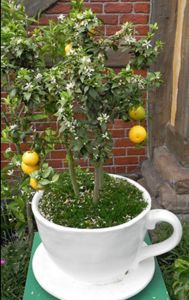Can’t ever figure out that perfect gift to give at the holidays? During the next gift giving season, why not try something a little different. Give a patio citrus tree! It’s a unique gift to give or receive here in the Sunshine State.
One of the pleasures nearly all homeowners in Florida can enjoy is the ability to pick fruits from their own trees. It is also an attractive addition to your holiday décor. However, landscapes and hardiness zones will dictate varieties that can be grown around your home. Patio or “potted” citrus that do not grow as large as other species will allow flexibility. Calamondin, key lime, kumquat, lemon, limequat and Tahiti lime are just some of the patio citrus favorites. These types of citrus are also sometimes marketed as dwarf, miniature or snowbird citrus. Although remember, growing any fruit tree in a container can help limit the size of the tree.
Figure 1: Patio Citrus.
Credit: UF/IFAS Communications.
There are special considerations to take into account with such fruit trees. All citrus need chilling hours each year to reset and to become viable fruit producers the following year. But, long hours of temperatures at or below freezing can cause irreversible damage. Some types of citrus have a higher tolerance to the cold, but lemons and limes tend to be less hardy than other species.
Having space in your home to move patio citrus is key. A spot with access to natural light will support growth during times when Panhandle temps drop significantly. Citrus require sun to grow and be healthy. Partial sun will slow the growth, if needed. A good rule of thumb is to treat patio citrus like a houseplant.
Most likely, from the time you purchase patio citrus, you’ll keep the tree in the pot for the first year or so. Be sure you re-pot as the tree grows. The tree will need to have adequate space in the pot for root development. A good quality potting soil is suitable for growing citrus. Also, be sure to consider weight, especially if you plan to move the pot indoors often.
In general terms, most container-grown plants do not thrive with of too little or too much watering. Rather, water only as needed. After wetting the soil, allow the top inch to become dry before watering again and make sure the container has drain holes. When fertilizing, do so in small amounts every few months. If the leaves are deeper green, then the tree is getting ample fertilizer. As time goes on, you’ll want to prune the tree to keep an appealing shape. Although pest problems are not usually an issue, a homeowner grade insecticide, neem oil or insecticidal soap are all good choices to use should problems arise.
As for fruitfulness, most citrus trees produce fruit, given time and proper care. So, please be patient. One major advantage to patio citrus, it’s easy to reach the fruit at harvest time!
For more information on patio citrus, please contact your local county extension office.
Supporting information for this article is provided by Dr. Pete Andersen of the UF/IFAS Research & Education Center in Quincy, FL, and information can also be found in the following the UF/IFAS publications: “Citrus Culture in the Home Landscape”, by Robert E. Rouse and Mongi Zekri: http://edis.ifas.ufl.edu/pdffiles/HS/HS13200.pdf & “Growing Fruit Crops in Containers”, by Larry K. Jackson and Jeffrey G. Williamson: http://edis.ifas.ufl.edu/pdffiles/MG/MG24300.pdf
UF/IFAS Extension is an Equal Opportunity Institution.
- Growing Shiitake Mushrooms - March 6, 2024
- Chinese Cabbage Becoming Increasingly Popular in Panhandle Gardens - January 4, 2024
- Mangroves, not just for South Florida anymore - September 20, 2023

